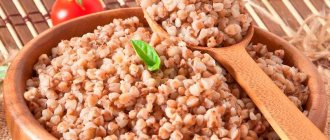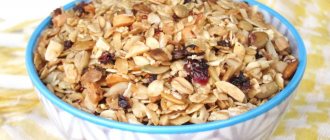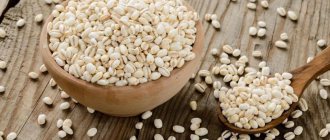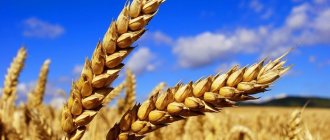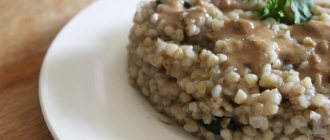Buckwheat with milk is a delicious dish, easy to prepare and provides the body with all the necessary substances for full functioning. When growing buckwheat, there is no need for additional fertilizers for its growth and high yield. Whole grains contain as much protein as meat, so they are indispensable in diets. This product has not yet been artificially recreated in the laboratory. What benefits can be gained by eating buckwheat with milk, and why this dish can be harmful - more on this later in the article.
Facts about buckwheat with milk
Some nutritionists, chemists, and doctors argue that buckwheat with milk is harmful and incompatible due to the fact that buckwheat contains a lot of iron, which is not absorbed with calcium, which is abundant in milk. It turns out that these two products are mutually exclusive. No one has fully understood this issue.
For example, in medicine, injections with synthesized B vitamins are given at different times of the day due to their incompatibility. But these vitamins as a complex are found in a piece of bread and are perfectly absorbed. It turns out that science is not yet ready to give a reliable and unambiguous answer to the question - is buckwheat compatible with milk?
Our ancestors ate buckwheat with milk and saw no harm from it. They fed their children this porridge, because buckwheat is a product that does not cause allergic reactions. The people grew up healthy and strong. Buckwheat is so good that it does not require any additional fertilizer for its growth and high yield. Buckwheat contains almost as much protein as meat, which makes it indispensable for diets and proper nutrition. This is one of the few products that has not yet been created artificially in the laboratory.
Buckwheat is a complex carbohydrate. This means that when a person digests this cereal, the body, in addition to receiving energy from food, also spends it on the process of digestion and assimilation. This is why buckwheat is so common in nutrition. It can be combined with almost any product, both protein foods and carbohydrate-containing and fatty foods.
Product combination
There was a belief that such a combination of products doubles the value of each of them. In addition, buckwheat porridge with milk tastes better, and the calorie content of the finished dish is low.
To understand whether such a breakfast will bring more benefit or harm, it is worth considering separately the properties of cereals and milk.
Properties of buckwheat
Buckwheat contains:
- trace elements: iron, magnesium, potassium, calcium, copper, chromium, selenium, iodine, phosphorus, silicon, boron, etc.;
- vitamins of groups B, E, P, PP, H;
- vitamins A, C;
- oxalic acid;
- protein, complex carbohydrates;
- alimentary fiber;
- lecithin, pectin.
Due to its composition, buckwheat is indispensable in the regular and dietary diet. It is universal because it does not cause allergies. Dishes prepared from it satisfy hunger for a long time, remove toxins and waste from the body, and improve digestion. The iron contained in buckwheat increases hemoglobin levels, helps stabilize the heart and the process of hematopoiesis, and minerals strengthen the immune system.
When digesting buckwheat, the body not only receives energy, but also spends it on the breakdown of complex carbohydrates, which means it spends calories. Thanks to all the listed properties, this cereal is highly valued by nutritionists.
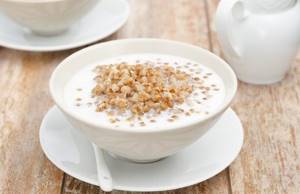
Properties of milk
Milk and products containing it are the main source of calcium. 400 ml contains half the daily intake of this mineral, which strengthens teeth and bones. In addition to this, milk contains:
- trace elements magnesium, phosphorus, copper, potassium, sodium, etc.;
- B vitamins;
- vitamins A, C, D, E, PP;
- protein.
Milk has a positive effect on the immune system, the functioning of the heart and blood vessels. The protein it contains strengthens muscle tissue, stabilizes the body's circadian rhythms, and promotes good sleep.
Doctors emphasize that milk is absorbed better in childhood: the body of an adult cannot receive the full complex of vitamins and minerals contained in this product.
Milk, like buckwheat, quickly causes a feeling of fullness. Many nutritionists consider it a heavy food and do not recommend mixing it with other foods.
Buckwheat with milk: benefits
Buckwheat with milk is prescribed as a dietary food for people who have received a high dose of radiation. For athletes, buckwheat is included in the mandatory diet: it strengthens muscles and increases endurance, normalizes blood pressure, and strengthens blood vessels. Buckwheat with milk is also useful for those who have been poisoned. Buckwheat helps remove toxins from the body.
For older people, it is useful as a product that normalizes cholesterol levels, prevents the appearance of cholesterol plaques and blockage of blood vessels. Eating buckwheat leads to normalization of blood sugar levels, which is important for people suffering from diabetes. Buckwheat is the main dietary product for solving obesity problems. It contributes to the gradual process of weight normalization.
Buckwheat porridge is recommended even for those who have problems with the nervous system. This product is unique, one of a kind - it has a beneficial effect on a person’s mental state. Reduces pain symptoms from migraines and headaches. Improves blood composition. Helps normalize the activity of the kidneys and liver, heart, blood vessels. With constant consumption of buckwheat, damaged liver cells are restored. This is especially important for those people who are undergoing rehabilitation after struggling with alcoholism and drug addiction. Buckwheat is also one of the first products in the fight against cancer. It is recommended to eat it to prevent cancer.
Glycemic index
To maintain good health, it is necessary to choose foods with a rich vitamin and mineral composition. It is important to pay attention to their nutritional content, protein, fat and carbohydrate content. The glycemic index (GI) value shows how quickly carbohydrates are broken down and converted into sugar. The standard of measurement is glucose. The blood sugar level after drinking it is 100 units.
Did you know? The GI value depends on the temperature of the product: absorption accelerates if the porridge is hot, and, conversely, slows down when the food is cooled.
According to the glycemic index, the following groups are distinguished:
- A characteristic feature of products with a low carbohydrate index (up to 55 units) is slow absorption in the gastrointestinal tract, a leisurely supply of sugar to the blood, without overloading the pancreas. The released energy is used evenly, without turning into fat, so it is enough for the body for several hours.
- Products with a high carbohydrate index (70 or higher units) tend to quickly increase blood sugar and generate a large amount of energy. The result of increased glucose levels is increased insulin secretion. This hormone regulates blood sugar. Excess glucose that is not converted into energy accumulates as fat, causing excess weight. Excessive amounts of the hormone interfere with the breakdown of lipids.
- By consuming low carbohydrate foods, you can:
- normal course of pregnancy;
- strengthening the activity of the heart muscle;
- stable energy levels throughout the day;
- increase in intellectual abilities and physical capabilities;
- good vision and healthy skin.
The glycemic index is influenced by a number of factors:
- food temperature;
- enzyme activity in the gastrointestinal tract;
- method of heat treatment of products;
- combination with other components.
Buckwheat with milk: harm
The largest number of allergies among the adult population is lactose intolerance. In other words, an adult does not absorb microelements and vitamins from milk in the same volumes and with the same quality as children.
On the contrary, the body reacts extremely negatively to buckwheat with milk. The stomach rejects bifidobacteria contained in milk. Passing further through the gastrointestinal tract, milk causes upset not only of the stomach, but also of the entire intestine: bloating, diarrhea, poor health, seething in the intestines, increased gas formation. All this leads to negative consequences in the form of allergic reactions: rash, redness, itching, swelling of the mucous membranes, which can be very dangerous.
Therefore, before consuming buckwheat with milk for its benefits, it is necessary to establish whether you are allergic to milk. If the result is positive, this product should be excluded. Milk allergies tend to subside as people get older.
Some argue that excessive consumption of buckwheat with milk causes irreparable harm to the body, since the blood is saturated with too much iron, which leads to damage to blood vessels and destabilization of all systems and organs. The fact is that the human body is a self-regulating system; it takes from foods and assimilates only the amount of minerals and trace elements that it needs to work. Otherwise, excess vitamins and other substances are simply eliminated.
If a person suffers from a disease in which the body cannot regulate the absorption of iron - Hemochromatosis, when iron is not absorbed but accumulates in tissues and joints, then one should be as careful as possible with the use of buckwheat. Also, buckwheat may be contraindicated in some cases in the presence of HIV infection.
How to prepare such dishes
No matter what they say, such food was, is and will be very popular among people of all ages. It is possible to prepare food in such a way that there are no negative consequences for the human body or they are minimized. Whatever cooking method is chosen, the cereal must be thoroughly washed before cooking, after which it must be lightly fried, for this you must use an exceptionally clean frying pan. Then the production of aroma will increase and more nutrients will remain in the product.
- The cereal is boiled in water, to which a small amount of salt is first added. The product is first filled with water, the mass boils, all this must be done over high heat, the lid must be closed. When the water boils, add a little salt, mix everything thoroughly, and then leave a small gap in the dish so that steam can escape freely. Then turn the heat as low as possible and cook everything until the liquid has completely evaporated. Then close the lid tightly and let it sit for another 10 minutes. And only then milk is added to the porridge;
- Buckwheat can be cooked not entirely in milk, but mixed halfway with water. Milk is mixed with water, then buckwheat is poured with it, after which you can use the classic cooking recipe. It’s just important not to add additional milk to the food after this, this will not only spoil the taste, but also neutralize most of the beneficial properties;
- You can use steaming in a thermos. Buckwheat is mixed with water at the rate of 1 to 1.5, the thermos is preheated, boiling water and a little salt are poured into it. The lid closes, the thermos shakes violently, everything needs to be mixed as actively as possible. Now let everything stand for an hour and a half or two. And then, when the porridge is ready, you can add warm milk;
- The product is first fried in a frying pan, a little salt is added, then boiling water is poured into it in such an amount that the grains are only slightly covered. Now you need to mix everything thoroughly, cover with a lid and let it sit on medium heat for about 7 minutes. Now put the closed frying pan in the oven, it should be preheated in medium mode, after which let everything simmer for about an hour. When everything is ready, the cereal is shaved with heated milk and you can eat it. For such purposes, it is advisable to use a frying pan with high edges.
If we are talking about elderly people and small children, then they should refrain from consuming such food, at least they definitely cannot eat this way all the time. But it is quite possible to eat the product a couple of times a month, but if the digestive system is disordered, then even this amount of the product must be discarded until everything returns to normal. If this is not done in time, your health will only worsen.
Buckwheat diet. Minus 12 kg in 2 WEEKS! Daily menu for a buckwheat diet
Recipe for losing weight and cleansing the body. Buckwheat on kefir.
If you find an error, please select a piece of text and press Ctrl+Enter.
The benefits of buckwheat with milk in folk medicine
There is an opinion, which is very widespread among the female population, that when preparing buckwheat with milk, these products mutually reinforce each other, increasing the digestibility of microelements, vitamins and minerals. This is the dish that is often prepared for young children. Warm milk has the ability to dissolve and evenly distribute everything that is mixed with it.
In the case of buckwheat with milk, bifidobacteria in the milk bind to vitamins and especially minerals, which are found in large quantities in buckwheat, which increases the absorption of nutrients from both products. It turns out that our ancestors were right in passing on such a recipe from generation to generation.
Useful links:
Recipe
This method of losing weight is classified as a mono-diet, that is, during the day, you cannot eat anything else except buckwheat with milk. Don't limit yourself to portions; if you're not full, eat a little more. Don't forget about plenty of water - at least 1.5 liters per day. So, how to cook buckwheat with milk for weight loss?
We will not boil the cereal, since after heat treatment a large number of beneficial properties are lost. It is necessary to rinse the buckwheat, add cold water and let it sit for about thirty minutes so that it swells a little. Drain the water and steam the cereal with boiling water, close the lid and leave for two hours. After this, fill it with low-fat milk.
After soaking in cold water, you can immediately steam it with milk, but you can’t boil it either, just warm it up well. Steam in milk for two hours too.
How much can you lose on this diet?
Everyone's body is unique, so different results may be achieved. On average, it is noted that in two weeks of diet you can get rid of 10 extra pounds.
But it is also necessary to take into account the fact that a fuller person will lose extra pounds faster than one whose initial weight is less.
A buckwheat diet for three days can be considered as an express course of weight loss. If you only need to slightly correct your figure, then the duration of the diet can be limited to these days.
If the goal is to achieve the greatest results, then the duration of the diet can be increased, but you should not overdo it here either.
It is better to repeat the diet after some time (after a month or two months) than, causing harm to the body, to stick to it for a month without breaks.
It should be noted that after finishing the buckwheat-milk diet, your weight may increase slightly. This is primarily due to the fact that salt has returned to the diet.


